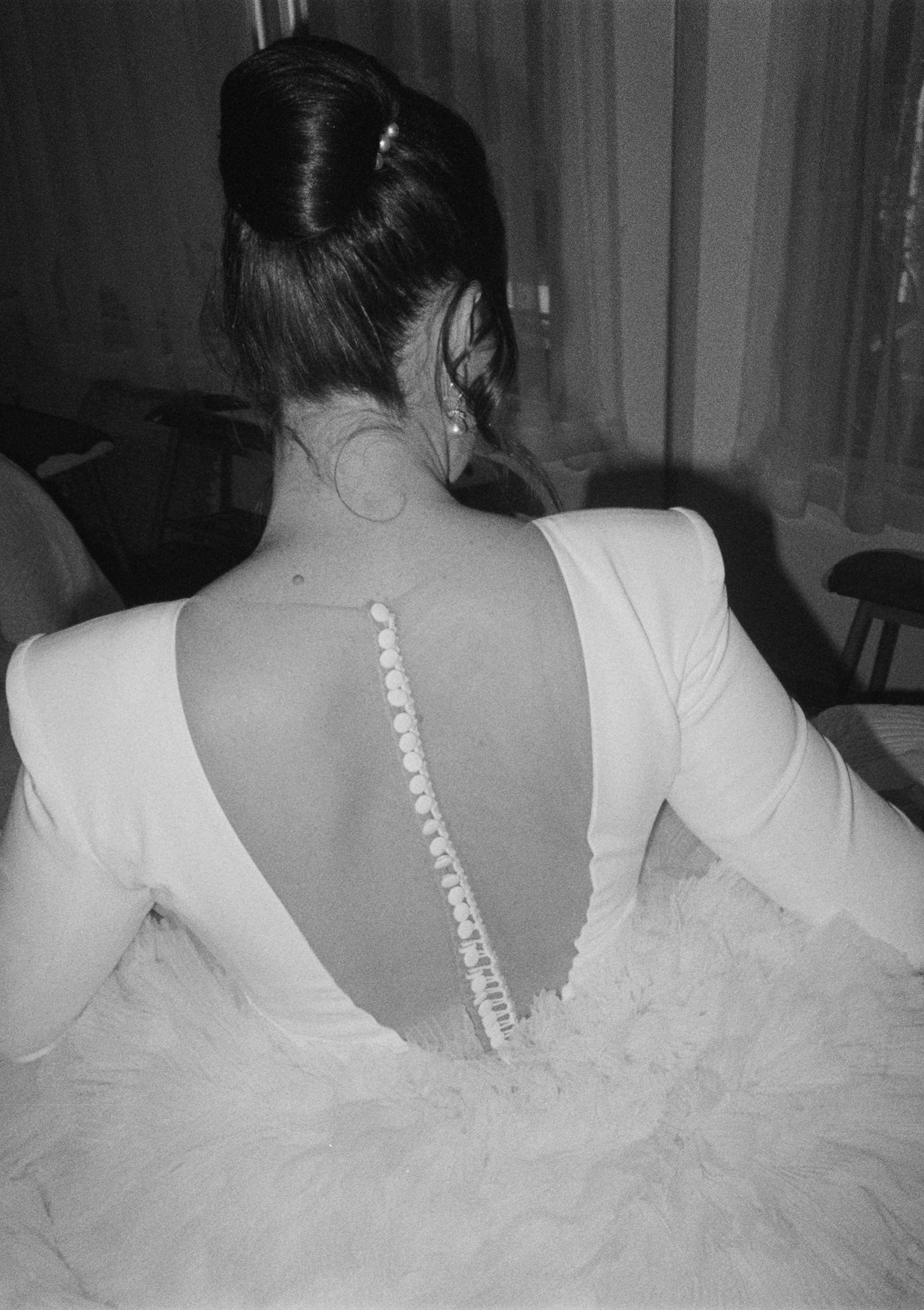Want a slice of 35mm film photography at your wedding? Read about our 35mm film and medium-format film collections for your wedding.
For over a decade we’ve been a film wedding photographer, and loved exploring the delicious variety of formats that over a century of this craft has afforded us. Usually we throw in a sprinkle of Kodak film, but more and more we’re being asked to photograph weddings entirely on film.
Featured weddings photographed on film
- Hayley and Christians Recoleta wedding
- Alexa and Alex’s Eilean Shona wedding
- Sharni and Michaels Cumulus wedding
- Lilli and Jakes Castemaine wedding
- Stephanie and Tim’s Paris Elopement





Introduction to Film Wedding Photography
In a world where digital dominates, there’s a growing band of couples opting to embrace the tangible, the textured, and the timeless. Film wedding photography isn’t just a retro nod; it carries the weight of history in every frame, capturing moments not in pixels but in grains, each telling a story that transcends the click of a shutter. The resurgence of film isn’t mere nostalgia for the good ol’ days; it’s a reclamation of artistry, a return to the roots of photography where every shot was deliberate, considered, and infused with a little bit of magic.
For those in Melbourne—and let’s face it, everywhere else who are in the know—film photography offers a richness that digital can never quite replicate. There’s a certain romance in the imperfection of a 35mm shot, the unpredictability of how light will dance across a scene. The allure of film lies not only in its aesthetic, but in the very process, in the anticipation of the developed roll, where each image is a surprise, a relic of a moment that can never be exactly reproduced.





Why is Film Wedding Photography experiencing a resurgence?
In an age where perfection is expected and everything is filtered within an inch of its life, film wedding photography stands as a micro act of rebellion. The grainy texture of 35mm film, the slight unpredictability of exposure, and the rich, organic colors are traditionally held up as the main virtues of shooting film, but the main benefits are the wonderful diversity of formats, and the ways that they change what the photographer chooses to photograph and how (when each press of the button can costs between $2-$4, you tend to… be calculated).



The Revival of 35mm Film in Modern Wedding Photography
It wasn’t too long ago that being a film wedding photographer would place you squarely in the bucket of neo-Amish, via something that belonged in your parents’ attic alongside vinyl records and bell-bottom jeans. But just like those vinyls, film photography has made a resounding comeback—and for good reason. The resurgence of 35mm film in wedding photography isn’t about nostalgia for nostalgia’s sake. It’s about a return to craftsmanship, to a time when every shot counted and each frame was precious. For modern couples, opting for film is a way of saying that your wedding isn’t just another event—it’s an occasion that deserves to be captured with intention and artistry.




Melbourne’s Best Film Wedding Photographers: Capturing Your Day in 35mm
Melbourne is a city that knows how to do things a little differently, and when it comes to wedding photography, that’s no exception. The city’s top film wedding photographers aren’t just snapping photos; they’re creating works of art, one frame at a time. Whether you’re getting married in a chic inner-city venue or surrounded by the natural beauty of the Yarra Valley, a film photographer will bring a unique perspective to your day. By choosing us, you’re ensuring that your wedding photos will be as distinctive and unforgettable as the day itself, captured in the beautiful, unpredictable glory of 35mm film. As for film labs, we prefer Hillvale photo lab here in Melbourne.






What about Super-8 film?
Filming weddings and elopements on gorgeous Super-8 film is something we’ve lent our hand to for years, and originally opened up the first Super-8 only wedding videography outfit in the world, Supergreat films. Since then we’ve just rolled it into an offer you can add-on to your photography coverage.
35mm Film wedding photography questions answered
All of our packages include some film. To enquire about the cost of having your wedding photographed on 100% analog film, make an enquiry on the contact page.
We use a mix of old cameras, as well as the very latest analogue film cameras that were ever made. All of them are regularly serviced by the leading analogue film camera technicians. And we carry backsups on backups, so there is never any risk of anything going wrong. In fact, since we’re not simply shooting everything on one digital SD card, you could even argue that having your wedding photos taken on analog film is even safer than digital.
Shooting your wedding on film means being even more careful when capturing moments. This means that we’ll typically come back with a fraction of the photos that we would for a wedding photographed on digital. With that said, you’ll still come away with a minimum of 300-400 finished film photos of your wedding, sometimes even more.
We use only the best stocks from Kodak and Cinestill. Typically, we can be seen waving our very favourites around: Cinestill 800, Ektar, Portra variants, and TMAX or Tri-X. Occasionally, we’ll even bring some special sauce that has become a unique part of my look and made us one of the most sought after film wedding photographers on the planet.
We’ve been planning one for years, and will be releasing a short course on how to be a film wedding photographer soon. Check back on our education here for photographers.
